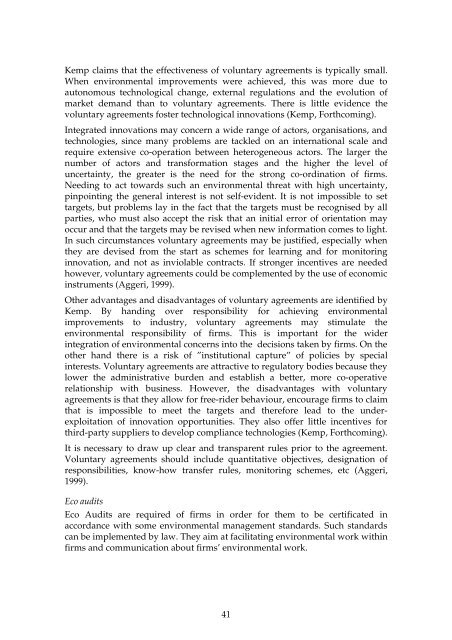Drivers of environmental innovation - Vinnova
Drivers of environmental innovation - Vinnova
Drivers of environmental innovation - Vinnova
You also want an ePaper? Increase the reach of your titles
YUMPU automatically turns print PDFs into web optimized ePapers that Google loves.
Kemp claims that the effectiveness <strong>of</strong> voluntary agreements is typically small.<br />
When <strong>environmental</strong> improvements were achieved, this was more due to<br />
autonomous technological change, external regulations and the evolution <strong>of</strong><br />
market demand than to voluntary agreements. There is little evidence the<br />
voluntary agreements foster technological <strong>innovation</strong>s (Kemp, Forthcoming).<br />
Integrated <strong>innovation</strong>s may concern a wide range <strong>of</strong> actors, organisations, and<br />
technologies, since many problems are tackled on an international scale and<br />
require extensive co-operation between heterogeneous actors. The larger the<br />
number <strong>of</strong> actors and transformation stages and the higher the level <strong>of</strong><br />
uncertainty, the greater is the need for the strong co-ordination <strong>of</strong> firms.<br />
Needing to act towards such an <strong>environmental</strong> threat with high uncertainty,<br />
pinpointing the general interest is not self-evident. It is not impossible to set<br />
targets, but problems lay in the fact that the targets must be recognised by all<br />
parties, who must also accept the risk that an initial error <strong>of</strong> orientation may<br />
occur and that the targets may be revised when new information comes to light.<br />
In such circumstances voluntary agreements may be justified, especially when<br />
they are devised from the start as schemes for learning and for monitoring<br />
<strong>innovation</strong>, and not as inviolable contracts. If stronger incentives are needed<br />
however, voluntary agreements could be complemented by the use <strong>of</strong> economic<br />
instruments (Aggeri, 1999).<br />
Other advantages and disadvantages <strong>of</strong> voluntary agreements are identified by<br />
Kemp. By handing over responsibility for achieving <strong>environmental</strong><br />
improvements to industry, voluntary agreements may stimulate the<br />
<strong>environmental</strong> responsibility <strong>of</strong> firms. This is important for the wider<br />
integration <strong>of</strong> <strong>environmental</strong> concerns into the decisions taken by firms. On the<br />
other hand there is a risk <strong>of</strong> ”institutional capture” <strong>of</strong> policies by special<br />
interests. Voluntary agreements are attractive to regulatory bodies because they<br />
lower the administrative burden and establish a better, more co-operative<br />
relationship with business. However, the disadvantages with voluntary<br />
agreements is that they allow for free-rider behaviour, encourage firms to claim<br />
that is impossible to meet the targets and therefore lead to the underexploitation<br />
<strong>of</strong> <strong>innovation</strong> opportunities. They also <strong>of</strong>fer little incentives for<br />
third-party suppliers to develop compliance technologies (Kemp, Forthcoming).<br />
It is necessary to draw up clear and transparent rules prior to the agreement.<br />
Voluntary agreements should include quantitative objectives, designation <strong>of</strong><br />
responsibilities, know-how transfer rules, monitoring schemes, etc (Aggeri,<br />
1999).<br />
Eco audits<br />
Eco Audits are required <strong>of</strong> firms in order for them to be certificated in<br />
accordance with some <strong>environmental</strong> management standards. Such standards<br />
can be implemented by law. They aim at facilitating <strong>environmental</strong> work within<br />
firms and communication about firms’ <strong>environmental</strong> work.<br />
41

















